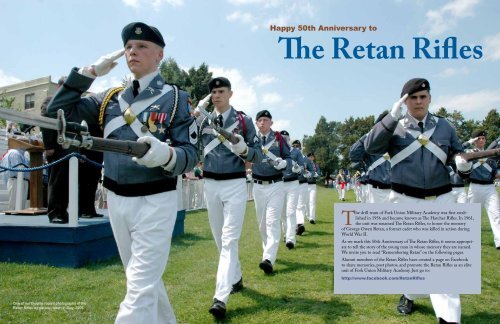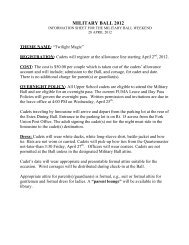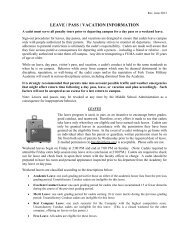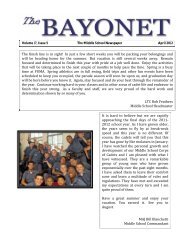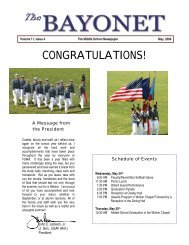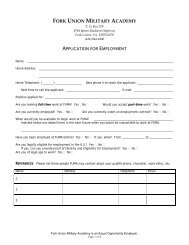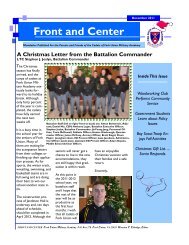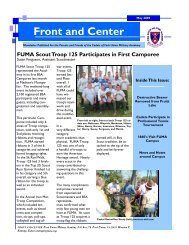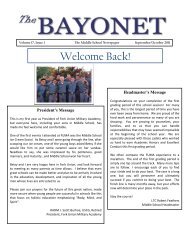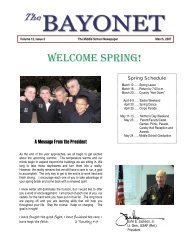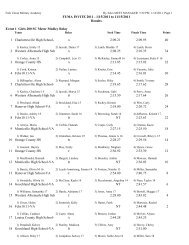The Retan Rifles - Fork Union Military Academy
The Retan Rifles - Fork Union Military Academy
The Retan Rifles - Fork Union Military Academy
You also want an ePaper? Increase the reach of your titles
YUMPU automatically turns print PDFs into web optimized ePapers that Google loves.
Happy 50th Anniversary to<br />
<strong>The</strong> <strong>Retan</strong> <strong>Rifles</strong><br />
<strong>The</strong> drill team of <strong>Fork</strong> <strong>Union</strong> <strong>Military</strong> <strong>Academy</strong> was first established<br />
in 1956 and became known as <strong>The</strong> Hatcher <strong>Rifles</strong>. In 1961,<br />
the unit was renamed <strong>The</strong> <strong>Retan</strong> <strong>Rifles</strong>, to honor the memory<br />
of George Owen <strong>Retan</strong>, a former cadet who was killed in action during<br />
World War II.<br />
As we mark this 50th Anniversary of <strong>The</strong> <strong>Retan</strong> <strong>Rifles</strong>, it seems appropriate<br />
to tell the story of the young man in whose memory they are named.<br />
We invite you to read “Remembering <strong>Retan</strong>” on the following pages.<br />
Alumni members of the <strong>Retan</strong> <strong>Rifles</strong> have created a page on Facebook<br />
to share memories, post photos, and promote the <strong>Retan</strong> <strong>Rifles</strong> as an elite<br />
unit of <strong>Fork</strong> <strong>Union</strong> <strong>Military</strong> <strong>Academy</strong>. Just go to:<br />
http://www.facebook.com/<strong>Retan</strong><strong>Rifles</strong><br />
One of our favorite recent photographs of the<br />
<strong>Retan</strong> <strong>Rifles</strong> on parade, taken in May, 2005.<br />
www.forkunion.com 45
<strong>The</strong> Hatcher <strong>Rifles</strong>, seen here in<br />
1957, were formed in the mid-1950s<br />
and were the forerunners of the<br />
<strong>Retan</strong> <strong>Rifles</strong>.<br />
It is fair to say that the <strong>Retan</strong> Rifle<br />
units of the mid-1980s were legendary<br />
for their precision and skill. <strong>The</strong><br />
unit is seen here in about 1982,<br />
marching in a community parade.<br />
<strong>The</strong> <strong>Retan</strong> <strong>Rifles</strong> have regularly<br />
appeared at the Dogwood Festival<br />
and Apple Blossom Parades, often<br />
taking home awards.<br />
<strong>The</strong> drill team was<br />
renamed the <strong>Retan</strong><br />
<strong>Rifles</strong> in 1961, and<br />
can be seen here<br />
performing on the<br />
<strong>Academy</strong>’s parade<br />
grounds in that year.<br />
Led by Constantine Wilson in 1982, the<br />
<strong>Retan</strong> <strong>Rifles</strong> traveled to Massanutten for<br />
a competition against rival teams on the<br />
east coast and won every single trophy<br />
to be awarded that day.<br />
Wilson continues to be involved in drill<br />
teams as founder of the New Guard<br />
America, performing exhibitions, competing,<br />
and training drill teams. Check<br />
him out at newguardusa.com<br />
<strong>The</strong> <strong>Retan</strong> <strong>Rifles</strong> would travel to Orlando<br />
in 1984 to compete in Nationals, where<br />
they placed third in the nation.<br />
Through the years the<br />
<strong>Retan</strong> <strong>Rifles</strong> became<br />
known for putting on<br />
elaborate and deathdefying<br />
performances<br />
spinning and throwing<br />
heavy military rifles<br />
with sharp bayonets<br />
affixed, as in this<br />
photo from 2005.<br />
Even the Silent Drill Team<br />
of the U. S. Marine Corps<br />
showed the <strong>Retan</strong> <strong>Rifles</strong><br />
a high level of respect,<br />
seen here stopping by their<br />
quarters to ask Cadet R. C.<br />
Schrom to teach them some<br />
of his tricks.<br />
46 Call to Quarters www.forkunion.com 47
Remembering<br />
<strong>Retan</strong><br />
“A nation reveals itself not only by the men it produces<br />
but also by the men it remembers, the men it honors.”<br />
<strong>The</strong> 506th Parachute Infantry Regiment jumped into<br />
Holland on September 17, 1944 as part of the largest<br />
airborne invasion ever made to that time.<br />
by Dan Thompson<br />
John F. Kennedy<br />
He stood erect and strong, his posture<br />
and sure step belying his age of almost<br />
eighty-nine years.<br />
“Can we stop here a moment” he’d asked. “I’d<br />
like to see that up close.” He remained for a long<br />
quiet minute or two, just reading the words of<br />
the plaque, taking it all in.<br />
IN HONORED MEMORY OF<br />
LT. GEORGE OWEN RETAN<br />
GRADUATED FORK UNION MILITARY ACADEMY<br />
JUNE 2, 1941<br />
KILLED IN ACTION HOLLAND<br />
SEPTEMBER 17, 1944<br />
Colonel Ed Shames walked slowly back to the<br />
golf cart and sat down heavily. Not a word was<br />
spoken as we rolled away to our next stop. For<br />
the first time during his visit on May 20, 2011,<br />
the open and engaging Colonel Shames seemed<br />
at a loss for words.<br />
“That really makes you think, “ Shames said finally.<br />
“Why him Why not me Why did I make<br />
it through and not George”<br />
It’s a Boy<br />
On February 1, 1923, a son was born to Dr.<br />
George Matthew <strong>Retan</strong> and his wife Emilie.<br />
After fathering two daughters, Geraldine<br />
and Lucille, there’s no doubt that Dr. <strong>Retan</strong><br />
was proud to have a son, but he was not to be<br />
named George Matthew <strong>Retan</strong>, Jr. It seems<br />
that Dr. <strong>Retan</strong>, an avid outdoorsman but very<br />
poor swimmer, had been on a fishing trip in the<br />
Adirondacks when he somehow managed to<br />
fall out of his canoe and found himself in deep<br />
trouble. His friend and fishing companion, a<br />
man named Owen, saved Dr. <strong>Retan</strong>’s life that<br />
day. And so it was decided that Dr. <strong>Retan</strong>’s son<br />
would carry the name George Owen <strong>Retan</strong>.<br />
Dr. <strong>Retan</strong> served as a professor of pediatrics at<br />
Syracuse University, and he maintained a private<br />
practice out of the family’s home on James<br />
Street in Syracuse, New York. Dr. <strong>Retan</strong> was<br />
something of a pioneer and researcher in medicine<br />
and his name remains a footnote in today’s<br />
medical journals. He owned one of the first x-ray<br />
48 Call to Quarters www.forkunion.com 49
George Owen <strong>Retan</strong><br />
entered FUMA in 1937<br />
as a freshman.<br />
<strong>Retan</strong> graduated as a<br />
senior in 1941.<br />
machines in private practice in New York. His<br />
early research on the treatment of a dangerous<br />
type of childhood intestinal blockage (known<br />
as intussusception) using a barium enema while<br />
observing the process by x-ray fluoroscopy was<br />
published and helped popularize this form of<br />
treatment. He also researched innovative treatments<br />
for childhood polio, and a chapter is<br />
dedicated to his efforts in a 1939 book entitled<br />
“Modern Miracle Men.” His controversial treatment<br />
methods became outdated, however, once<br />
the polio vaccine was developed.<br />
Cadet <strong>Retan</strong><br />
George Owen <strong>Retan</strong> seemed to have inherited<br />
his father’s intelligence, and he began to distinguish<br />
himself as a student when he enrolled as a<br />
freshman at <strong>Fork</strong> <strong>Union</strong> <strong>Military</strong><br />
<strong>Academy</strong> in September of 1937<br />
and was assigned to C Company.<br />
His freshman year he earned a report<br />
card filled with mostly A’s and<br />
only the occasional grade of B.<br />
<strong>The</strong> society pages of the Syracuse<br />
newspapers often carried news<br />
of Dr. George <strong>Retan</strong>, the wellknown<br />
physician, and his family.<br />
Dr. <strong>Retan</strong> and his wife earned<br />
frequent mentions in the local<br />
press for their participation in various cultural<br />
and charitable activities in Syracuse, so when<br />
young George Owen <strong>Retan</strong> made the honor<br />
roll at <strong>Fork</strong> <strong>Union</strong> <strong>Military</strong> <strong>Academy</strong>, that news<br />
was prominently reported in the hometown<br />
newspaper.<br />
Cadet <strong>Retan</strong> earned officer’s rank during his four<br />
years of high school at the <strong>Academy</strong> and served<br />
as part of the editorial staff for the “Skirmisher”<br />
(the <strong>Academy</strong>’s yearbook) and as an officer in<br />
the Athenian<br />
Literary Society.<br />
His senior photograph<br />
shows a<br />
clear-eyed young<br />
man in an officer’s<br />
coatee with two<br />
stars at his collar.<br />
<strong>The</strong>se stars<br />
were worn on the<br />
uniform at that<br />
time as “academic stars” indicating outstanding<br />
performance in the classroom, and the officer’s<br />
rank was worn on the sleeve. <strong>Retan</strong>’s academic<br />
achievement earned him admission to one of the<br />
nation’s top Ivy League institutions. He enrolled<br />
in the prestigious Cornell University following<br />
his graduation from <strong>Fork</strong> <strong>Union</strong> <strong>Military</strong><br />
<strong>Academy</strong> on June 2, 1941.<br />
Winds of War<br />
As George Owen <strong>Retan</strong> embarked on his college<br />
career as a freshman at Cornell, the United<br />
States was facing the likelihood of greater<br />
involvement in the war that had been building<br />
on the European continent and stretching<br />
into Africa and Asia. Hitler in Germany and<br />
Hirohito in Japan were spreading turmoil across<br />
much of the world and the Americans would not<br />
be able to stand on the sidelines much longer.<br />
On December 7, 1941, the Japanese launched<br />
a surprise raid on Pearl Harbor, sinking many<br />
ships of the U. S. Navy and guaranteeing the<br />
Americans’ entry into World War II. <strong>The</strong> very<br />
next day, George <strong>Retan</strong> left the campus of<br />
Cornell University to visit his father in the office<br />
of his medical practice. He declared to his<br />
father his intention to leave college and join the<br />
military.<br />
<strong>Retan</strong> finished out his freshman year, even joining<br />
the Phi Delta <strong>The</strong>ta fraternity, but he made<br />
good on his plans to join the war effort in the<br />
summer of 1942.<br />
You’re In the Army Now<br />
On August 25, 1942, George Owen <strong>Retan</strong><br />
enlisted in the United States Army. When he<br />
asked the recruiter where they needed men the<br />
most, he was told they needed paratroopers, so<br />
that’s where <strong>Retan</strong> volunteered to serve.<br />
<strong>The</strong> 506th Parachute Infantry Regiment was to<br />
be a new “super unit” of elite fighters, kind of a<br />
precursor to today’s Delta Force or Seal Team<br />
Six. <strong>The</strong> 506th PIR recruited only men of better<br />
than average intelligence and physical condition,<br />
and sent them to Camp Toccoa in a remote part<br />
of Georgia to undergo the most rigorous training<br />
schedule any military unit to that time had<br />
been required to complete.<br />
Ed Shames recalls that he and <strong>Retan</strong> must<br />
have arrived at Camp Toccoa on the same train,<br />
as they ultimately were assigned together to<br />
Company I in the Third Battalion of the 506th.<br />
Shames describes the training they went through<br />
as “almost inhumane” as the men were winnowed<br />
from almost 7,000 recruits down to about 2,500<br />
tough, hardened fighting men. Anyone who<br />
stopped running on the regular morning runs<br />
3-1/2 miles up (and 3-1/2 miles down) Currahee<br />
Mountain was removed from the unit. Anyone<br />
who was unable to qualify at the “expert” level<br />
with their rifle, machine gun, or mortar was<br />
eliminated. When the regiment was sent to the<br />
large rifle ranges at Clemson University to finish<br />
perfecting their marksmanship skills, no trucks<br />
were on hand to transport them. <strong>The</strong>y marched<br />
the 48 miles from Toccoa to Clemson. Anyone<br />
who fell out during the long march was removed<br />
from the unit.<br />
During this arduous training, a strong bond<br />
was formed between five friends in I Company,<br />
Shames reports. Joe Madona, Joe Beyerle, James<br />
Recruiting posters like this one encouraged<br />
men between the ages of 18 and 32 to join the<br />
Army paratroopers.<br />
Japhet, Ed Shames, and George <strong>Retan</strong> became<br />
fast friends, with George as kind of their leader.<br />
<strong>Retan</strong> seemed to know the ropes and helped<br />
them all through the training regimen, Shames<br />
recalls, displaying a level of leadership and<br />
experience that Shames now credits to <strong>Retan</strong>’s<br />
background as a FUMA cadet. “He must have<br />
learned that here,”<br />
Shames says. “I just<br />
tried to follow his<br />
lead.”<br />
<strong>Retan</strong>’s leadership<br />
abilities were noticed<br />
by his commanding<br />
officers, and <strong>Retan</strong><br />
was soon promoted<br />
to Sergeant and<br />
placed in charge of a<br />
squad.<br />
In December of<br />
1942, the regiment<br />
was to travel to Fort<br />
Benning for parachute<br />
jump school.<br />
First Battalion traveled<br />
by train from<br />
Toccoa to Benning.<br />
Second Battalion<br />
marched 102 miles<br />
to Atlanta in three days and then took a train to<br />
Benning. Third Battalion, <strong>Retan</strong>’s battalion, took<br />
the train to Atlanta, and then marched 136 miles<br />
in four days to arrive at Fort Benning, smashing<br />
a record for long distance marching previously<br />
set by the Imperial Japanese Army. <strong>The</strong> 506th<br />
PIR was attracting attention as an elite airborne<br />
unit like none before.<br />
More specialized training continued for the regiment<br />
and by February of 1943, Ed Shames had<br />
also been promoted to Staff Sergeant and moved<br />
to Headquarters Staff, but he still remained close<br />
with his buddies in I Company.<br />
On September 5, 1943, the regiment boarded<br />
the troop ship Samaria and sailed for England.<br />
<strong>The</strong> 506th Parachute Infantry Regiment was<br />
soon to become one of the most renowned units<br />
of the 101st Airborne Division. George <strong>Retan</strong><br />
and his buddies were going to war.<br />
<strong>Retan</strong> was promoted<br />
to Sergeant within<br />
months of his enlistment<br />
in the 506th<br />
Parachute Infantry<br />
Regiment.<br />
50 Call to Quarters www.forkunion.com 51
D-Day: <strong>The</strong> Normandy Invasion<br />
As the landing craft hit the beaches at Omaha<br />
Beach and Utah Beach at dawn on June 6, 1944,<br />
George <strong>Retan</strong> and his comrades had already<br />
been in combat for several hours.<br />
<strong>The</strong> 506th Parachute Infantry Regiment was one<br />
of a number of airborne units that jumped into<br />
German-held territory in the hours past midnight.<br />
<strong>The</strong> Third Battalion of the 506th was to<br />
secure two bridges across the Douve River east<br />
of the town of Carentan, France. <strong>The</strong> Germans<br />
had built these bridges in recent months so they<br />
could quickly move reinforcements to the beach<br />
to meet the expected invasion. It was critical<br />
that these bridges be seized and controlled if the<br />
beach landings were to succeed.<br />
In the darkness, amid a hail of anti-aircraft fire,<br />
the transport planes bucked and swerved, trying<br />
to find their drop zones. Paratroopers jumped<br />
into uncertainty on that black night, very few<br />
landing anywhere close to their targets, most<br />
landing miles away from their objective.<br />
<strong>Retan</strong>’s buddy, James Japhet, never made it into<br />
the fight. His plane was hit and the right engine<br />
and wing caught on fire. <strong>The</strong> paratroopers were<br />
unable to jump and the plane crashed, killing all<br />
aboard.<br />
Joe Beyerle landed on a church in Saint-Cômedu-Mont<br />
and slid down the roof to the ground<br />
below. Alone, Beyerle tried to make his way<br />
toward his objective but was captured by the<br />
Germans and spent months in POW camps<br />
before escaping and joining up with Soviet<br />
Army forces with whom he fought through the<br />
remainder of the war.<br />
Joe Madona’s plane dropped him far from his<br />
intended drop zone and into the area of operations<br />
for the 82nd Airborne. He landed in a field<br />
flooded by the Germans to hinder paratroopers<br />
and had to act quickly to save himself and<br />
a nearby comrade from drowning on landing.<br />
Madona would survive Normandy but was killed<br />
in action at Bastogne in January of 1945.<br />
Ed Shames landed on the grounds of the<br />
Carnation Milk factory near Carentan, all alone.<br />
He quickly set about finding other paratroopers<br />
and leading the way, many miles, to the bridges<br />
that were their objective.<br />
Like his buddies, George <strong>Retan</strong> was dropped<br />
far away from his intended target, and within<br />
the first five minutes was wounded in the leg by<br />
shrapnel. He met up with Colonel Sink’s headquarters<br />
outfit and continued fighting for the<br />
next three days despite his wounds, until units<br />
from Utah Beach broke through and joined with<br />
them in the days following D-Day.<br />
<strong>Retan</strong> was awarded the Bronze Star and the<br />
Purple Heart, though he evidently never spoke<br />
of the deeds that earned his medal for valor<br />
with his good friend Ed Shames. Shames recalls<br />
that <strong>Retan</strong> didn’t talk much about his injury or<br />
D-Day experiences, just wearing a patch on his<br />
leg. But then, most of the paratroopers landing<br />
behind enemy lines, including Shames, had<br />
wounds to show for their first experience in<br />
combat.<br />
In the weeks following the Normandy Invasion,<br />
<strong>Retan</strong>’s wounds were treated but not all the<br />
shrapnel could be removed. He was offered the<br />
oppportunity to return to the United States for<br />
further treatment, but he elected to remain with<br />
his unit.<br />
In the confusion and fog of war, <strong>Retan</strong> and<br />
Shames had each, separately, distinguished<br />
themselves in combat and demonstrated the<br />
special kind of leadership needed to command<br />
fighting men. <strong>The</strong>y were both selected to receive<br />
battlefield commissions following Normandy<br />
and were promoted from Staff Sergeant to 2nd<br />
Lieutenant rank, two of only three men in the<br />
regiment to receive this recognition.<br />
Ed Shames was transferred to E Company in<br />
the 2nd Battalion of the 506th and placed in<br />
command of the company’s “patrol platoon.”<br />
George <strong>Retan</strong> was moved to A Company in<br />
the 1st Battalion of the 506th as the Assistant<br />
Platoon Leader of the 2nd Platoon.<br />
A Quiet and Humble Leader<br />
Bill Chivvis was a young soldier assigned to I<br />
Company as a replacement in the days following<br />
Normandy. As the Normandy veterans began<br />
returning to Ramsbury, England, Bill Chivvis<br />
and his fellow replacements got to see <strong>Retan</strong> in<br />
action.<br />
“After a time we became aware of <strong>Retan</strong> visiting<br />
the Company ‘I’ area to greet his returning<br />
friends. On each visit he would stop and talk<br />
to the ‘know nothing’ replacements and try to<br />
answer our stupid questions. <strong>The</strong>re is no greater<br />
gulf than that which exists between combatants<br />
and non-combatants but this did not affect<br />
<strong>Retan</strong>.”<br />
<strong>Retan</strong>’s behavior made an impact on this fresh<br />
young recruit. “From these brief visits, I learned<br />
a lesson which would follow me through the<br />
Holland and Belgium campaigns: I always took<br />
the time to talk to incoming replacements.”<br />
<strong>The</strong>se few encounters with George <strong>Retan</strong> made<br />
a lifelong impression on Chivvis, who spoke of<br />
<strong>Retan</strong> in a 1995 letter to researcher and author<br />
Peter Hendrikx. “I will describe <strong>Retan</strong> as a quiet,<br />
humble young man, but very intelligent, very<br />
alert, and very focused. He was a natural leader<br />
who inspired confidence without even trying. He<br />
was a man of the highest character.”<br />
Operation Market Garden<br />
In just a few short weeks, the 506th was headed<br />
back into combat, part of the largest airborne<br />
invastion ever undertaken to that time. <strong>The</strong> plan<br />
was for American and British forces to capture<br />
a number of bridges in Holland, giving the<br />
Allies an access route into Germany around the<br />
Siegfried Line defenses.<br />
<strong>The</strong> 506th jumped in clear skies on the afternoon<br />
of September 17, 1944 into a large field<br />
near the town of Son. <strong>The</strong> daylight jump, made<br />
possible by Allied air superiority, was a big improvement<br />
on the confusion seen at Normandy.<br />
<strong>The</strong> regiment landed almost in formation and<br />
met little resistance as they left the drop zone.<br />
Company A was to capture the main bridge<br />
across the Wilhelmina Canal at Son. Almost<br />
half of 1st Platoon had been dropped some<br />
distance from the rest of the company, so 2nd<br />
Platoon was placed in the lead. Platoon Leader<br />
1st Lieutenant Galarneau had broken his ankle<br />
on the jump, so it was up to 2nd Lieutenant<br />
George <strong>Retan</strong> to lead the regiment through the<br />
Son Forest toward their target.<br />
About 400 yards into their advance, the company<br />
engaged a number of German riflemen,<br />
suppressing their fire and continuing to push<br />
toward the bridge.<br />
When the company reached a point in the<br />
woods about 200 yards from the bridge, all of a<br />
sudden one of the three 88mm artillery pieces<br />
guarding the bridge opened fire into the trees.<br />
Sgt. Joe Powers of 2nd Platoon was hit by shrapnel<br />
and wounded almost immediately. Soon the<br />
other two large 88mm guns had lowered their<br />
barrels and begun firing into the woods. <strong>The</strong><br />
88mm gun is designed to shoot planes from the<br />
sky, but the Germans had found it to be a terrible<br />
and terrifying anti-infantry gun as well. <strong>The</strong><br />
88s were soon joined by the thump of 81mm<br />
mortars.<br />
“Men were being killed,” recalls Donald R.<br />
Burgett, a soldier in A Company. “We had to do<br />
something.”<br />
Company A faced only one choice. <strong>The</strong>y had<br />
to attack headlong into the massed fire of three<br />
fearsome cannons.<br />
<strong>The</strong> soldiers raced through the woods and then<br />
across the grass straight into the muzzle blasts<br />
of the massive artillery pieces. After overwhelming<br />
the Germans at the guns and silencing the<br />
<strong>Retan</strong> and A Company<br />
of the 506th PIR led<br />
the attack on the<br />
bridge at Son, into the<br />
face of three 88mm<br />
artillery guns.<br />
52 Call to Quarters www.forkunion.com 53
In this remarkable photo taken near the Son bridge, an American trooper stands at one of the 88mm gun<br />
emplacements captured by the Americans, one of the three guns that killed <strong>Retan</strong> and killed or wounded<br />
so many of his men on that afternoon of September 17, 1944.<br />
artillery, the paratroopers then stormed the<br />
remaining yards toward the bridge to seize their<br />
objective, but the Germans set off pre-placed<br />
explosives just before the Americans set foot on<br />
the structure, blowing it up in their faces.<br />
As the smoke cleared and A Company regrouped,<br />
the costs of the short fierce battle were<br />
plain to see.<br />
“Our company lost nearly 30 percent of our<br />
officers and men in the Son Forest. Lieutenant<br />
<strong>Retan</strong> was among the first of our men to be<br />
killed in the woods,” recalls Don Burgett.<br />
“Within hours of our landing in Holland, A<br />
Company had been battered in battle and bathed<br />
in blood.”<br />
‘Til the Boys Come Home<br />
Don Burgett would continue fighting through<br />
Europe with A Company of the 506th and return<br />
home from the war to write several gripping<br />
books about his experiences, each widely hailed<br />
for their first-person vividness.<br />
Ed Shames (who was just a quarter-mile or so<br />
away at Son and learned quickly of his close<br />
friend’s death) would continue to lead his<br />
platoon of Easy Company soldiers on through<br />
Belgium, Bastogne, Berlin, and into the pages of<br />
history as Stephen Ambrose’s famed “Band of<br />
Brothers.” Shames earned the distinction of returning<br />
more soldiers home, safe and alive, than<br />
any other platoon leader in the 101st Airborne<br />
Division. This despite the fact that his platoon<br />
was often called on to undertake dangerous<br />
patrols and assignments.<br />
For George Owen <strong>Retan</strong>, however, his war<br />
ended on September 17, 1944 in the Son Forest<br />
of Holland. He lies in Plot A, Row 4, Grave<br />
8 of the Netherlands American Cemetery at<br />
Margraten. His resting place is attended to<br />
regularly by citizens of that country who have<br />
adopted the graves of the American fallen. His<br />
bright white headstone is cleaned regularly and<br />
flowers placed by these grateful citizens who<br />
insure that the sacrifice for freedom he made on<br />
their soil will not be soon forgotten.<br />
54 Call to Quarters www.forkunion.com 55
FUMA Remembers<br />
George <strong>Retan</strong> was not forgotten on the campus<br />
of <strong>Fork</strong> <strong>Union</strong> <strong>Military</strong> <strong>Academy</strong>. As a four-year<br />
cadet and a high-performing student, <strong>Retan</strong><br />
had made quite an impression on the staff and<br />
faculty as well. It is clear that the affection was<br />
mutual, as George <strong>Retan</strong> had expressly requested,<br />
before heading overseas, that if anything<br />
happened to him, his savings should be donated<br />
to <strong>Fork</strong> <strong>Union</strong> <strong>Military</strong> <strong>Academy</strong>.<br />
Dr. George M. <strong>Retan</strong> was devastated by his<br />
son’s death. He closed his private practice and<br />
spent much of his time building a log lodge on<br />
a remote lake in Canada, a kind of refuge for<br />
him. But Dr. <strong>Retan</strong> and his wife honored their<br />
son’s wishes, and his savings were donated to the<br />
<strong>Academy</strong>, where they helped fund the construction<br />
of the school’s new library.<br />
On October 11, 1949, Dr. and Mrs. George<br />
M. <strong>Retan</strong> came to the campus of <strong>Fork</strong> <strong>Union</strong><br />
<strong>Military</strong> <strong>Academy</strong> for the dedication of the<br />
<strong>Retan</strong> Library.<br />
<strong>The</strong> <strong>Retan</strong> <strong>Rifles</strong><br />
In the fall of 1960, another young freshman<br />
entered the <strong>Academy</strong>, the son of Lucille <strong>Retan</strong><br />
Ramseyer, George <strong>Retan</strong>’s beloved sister.<br />
“From the moment I was born, I was destined<br />
to be a cadet at <strong>Fork</strong> <strong>Union</strong> <strong>Military</strong> <strong>Academy</strong>,”<br />
jokes George Owen Ramseyer.<br />
<strong>The</strong> arrival of George <strong>Retan</strong>’s nephew and<br />
namesake on campus apparently awakened fond<br />
memories among the faculty and staff who recalled<br />
his uncle’s arrival more than twenty years<br />
earlier. Early in 1961 it was<br />
decided that the <strong>Academy</strong>’s<br />
crack drill team, then called<br />
the Hatcher <strong>Rifles</strong>, would be<br />
renamed to honor George<br />
Owen <strong>Retan</strong>. In a special<br />
ceremony, a <strong>Retan</strong> <strong>Rifles</strong> banner<br />
was presented to young<br />
George Owen Ramseyer.<br />
<strong>The</strong> <strong>Retan</strong> <strong>Rifles</strong> carry that<br />
name to this day, and each<br />
year, a number of outstanding<br />
young cadets carry his name on their sleeves,<br />
a living memorial to honor his service and<br />
sacrifice.<br />
Recalling a Fallen Friend<br />
Standing beside the brass plaque on the wall<br />
dedicating the building to the memory of his<br />
friend, Ed Shames felt the memories come<br />
flooding back, these nearly 67 years later.<br />
“It’s incredible,” he said, of learning that his<br />
young comrade was one of FUMA’s most honored<br />
alumni. “It’s just indescribable.”<br />
Now a Colonel, though retired from his service<br />
to the nation, Shames had volunteered to come<br />
to FUMA to talk to cadets about his fallen<br />
friend.<br />
Standing in front of the entire upper school<br />
Corps of Cadets, Shames wore a bright yellow<br />
jacket covered in patches honoring the<br />
506th Parachute Infantry Regiment, the 101st<br />
Airborne Division of which they were a part,<br />
and Easy Company, his own band of brothers.<br />
<strong>The</strong> jacket was a gift from the HBO producers<br />
of the mini-series about his famed unit. “<strong>The</strong>y<br />
made $190 million telling our story, “ quipped<br />
Shames. “All I got was this jacket.”<br />
Shames shared stories of the training that he and<br />
George <strong>Retan</strong> had endured together at Currahee<br />
Mountain. He answered questions about<br />
Bastogne, the daring rescue of British paratroopers<br />
across the Rhine River, and many other<br />
exploits with Easy Company. Current members<br />
of the <strong>Retan</strong> <strong>Rifles</strong> crowded around after his<br />
talk, and Shames autographed copies of the book<br />
“Tonight We Die As Men” for which he had<br />
authored the foreward. Shames had brought the<br />
books, which tell the story of the Third Battalion<br />
of the 506th, as a special gift to the <strong>Retan</strong> cadets<br />
and the school’s library.<br />
Although he only lived a short twenty-one years,<br />
the lessons to draw from <strong>Retan</strong>’s life seem clear.<br />
Study hard, volunteer where you are needed, do<br />
your best, accept responsibility, lead from the<br />
front, be kind and gracious to all.<br />
When asked how the young men of FUMA<br />
could best honor the memory of George Owen<br />
<strong>Retan</strong>, Shames offered the following simple advice:<br />
“Work hard. Try to be great at something.<br />
If you can’t be great, be good. If you can’t be a<br />
good leader, be a good follower. But be good.<br />
George was no angel, but he was good hearted.<br />
George <strong>Retan</strong> was a good man.”<br />
Donald Burgett returned to Holland a few years<br />
ago to revisit the ground where he and his<br />
comrades in A Company had battled in 1944. He<br />
took time to visit Margraten Cemetery and take<br />
this photo beside the grave of George O. <strong>Retan</strong>,<br />
one of the lieutenants in his company.<br />
Recommended Reading<br />
Tonight We Die As Men:<br />
<strong>The</strong> Untold Story of the Third<br />
Battalion 506 Parachute Infantry<br />
Regiment from Toccoa to D-Day<br />
By Ian Gardner and Roger Day<br />
Foreward by Ed Shames<br />
Currahee!<br />
<strong>The</strong> Road to Arnhem<br />
By Donald R. Burgett<br />
Colonel Ed Shames visited the<br />
campus recently to speak with cadets<br />
about <strong>Retan</strong> and World War II. After<br />
his talk he signed books as gifts for<br />
current <strong>Retan</strong> Rifle members.<br />
<strong>The</strong> article on the following<br />
pages (“Shuford and the<br />
Chief ”) is a chapter reprinted<br />
by permission of Flying Point<br />
Press from this book:<br />
Invasion: <strong>The</strong> Story of D-Day<br />
By Bruce Bliven, Jr.<br />
All these books are available<br />
at Amazon.com and Barnes<br />
& Noble.<br />
56 Call to Quarters www.forkunion.com 57


